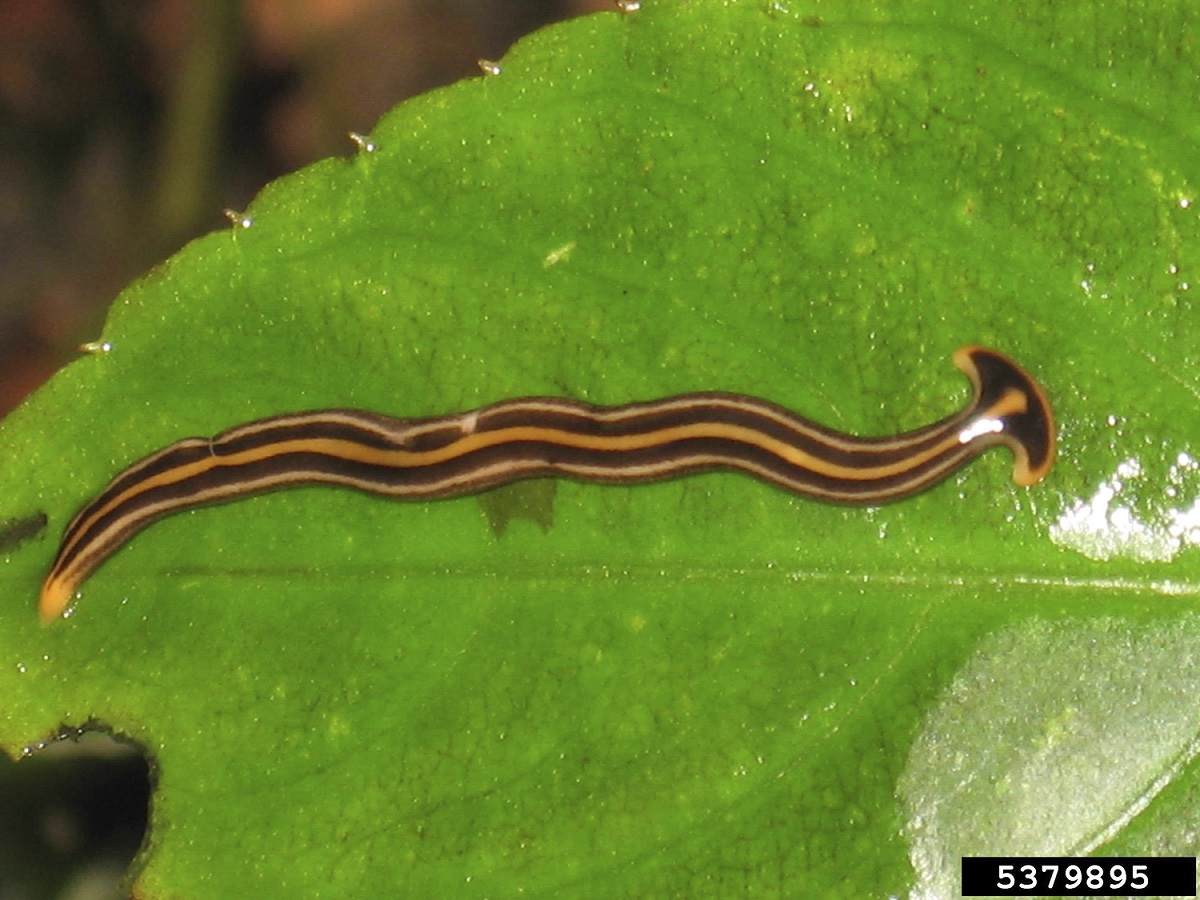
This undated image provided by Bugwood.org shows a hammerhead worm on a leaf in India. The narrow, snakelike flatworm has a head built like that of a hammerhead shark.
11:17 JST, August 21, 2024
Earthworms, as we know, are garden champions, cleaning the soil by eating their weight in organic matter every day and aerating it as they wriggle around, creating tunnels to ease root growth. They also improve soil moisture, remove fungal spores and stimulate microbial activity, which benefits plant health.
But there’s another weird worm out there that’s toxic, deadly to our beloved earthworms and nearly impossible to kill: Allow me to introduce you to the hammerhead worm.
As its name would imply, the narrow, snakelike flatworm has a head built like that of a hammerhead shark. And it’s hardly a newcomer, believed to have hitched a ride to the U.S. from Southeast Asia with a shipment of plants around 1900.
Usually 2 to 3 inches in length with vertical stripes running the length of their bodies, the invertebrates can grow up to 15 inches long. And they’re a force to be reckoned with.
Although they are ravenous earthworm hunters, hammerheads are coated in the same paralytic neurotoxin present in pufferfish, which keeps birds and other insects from preying on them. This gives them a decisive advantage in the food chain.
That chemical coating is toxic to pets and would likely irritate your skin if you were to pick up a worm. To add insult to injury, their bodies contain parasitic nematodes, tiny roundworms that feed on plants and can parasitize humans, animals and beneficial insects.
As carnivorous cannibals, the worms eat snails, slugs and each other (no love lost there), as well as earthworms, the loss of which would pose a catastrophic threat to farms and gardens.
Hammerhead worms are hermaphroditic, so they reproduce without a mate. But that’s not the only way they multiply: Their favorite party trick is detaching a portion of their rear ends and leaving them on plants, where, within 10 days — presto, chango! – those little butts grow heads and become offspring. If you were to chop a hammerhead worm to bits, each would grow into a new hammerhead worm. Don’t do it.
The slithering pests love heat and humidity, so they initially made their homes in Alabama, California, Florida, Georgia, Louisiana, Mississippi, South Carolina and Texas. But greenhouses are also hot and humid, so the worms have been inadvertently transported on nursery plants to gardens in Arkansas, Illinois, Kentucky, Massachusetts, Michigan, Missouri, North Carolina, New Jersey, New York, Ohio, Oklahoma, Tennessee, Virginia and Washington, D.C. They’ve also been found in Hawaii and Ontario, Canada.
Preferring to hide under leaf litter, shrubs, rocks and logs, the worms can go largely unnoticed. But if you spot one, don’t squash or cut it (that would just make more). The only way to kill hammerhead worms is to pour salt or vinegar on them.
"News Services" POPULAR ARTICLE
-

American Playwright Jeremy O. Harris Arrested in Japan on Alleged Drug Smuggling
-

Japan’s Nikkei Stock Average as JGB Yields, Yen Rise on Rate-Hike Bets
-

Japan’s Nikkei Stock Average Licks Wounds after Selloff Sparked by BOJ Hike Bets (UPDATE 1)
-

Japan’s Nikkei Stock Average Buoyed by Stable Yen; SoftBank’s Slide Caps Gains (UPDATE 1)
-

Japanese Bond Yields Zoom, Stocks Slide as Rate Hike Looms
JN ACCESS RANKING
-

Tokyo Economic Security Forum to Hold Inaugural Meeting Amid Tense Global Environment
-

Keidanren Chairman Yoshinobu Tsutsui Visits Kashiwazaki-Kariwa Nuclear Power Plant; Inspects New Emergency Safety System
-

Imports of Rare Earths from China Facing Delays, May Be Caused by Deterioration of Japan-China Relations
-

University of Tokyo Professor Discusses Japanese Economic Security in Interview Ahead of Forum
-

Japan Pulls out of Vietnam Nuclear Project, Complicating Hanoi’s Power Plans



























